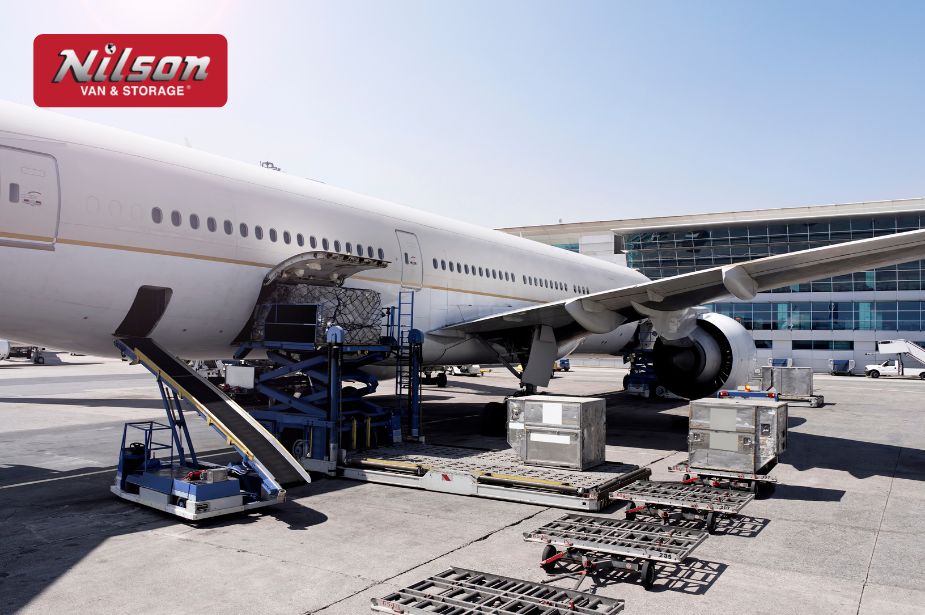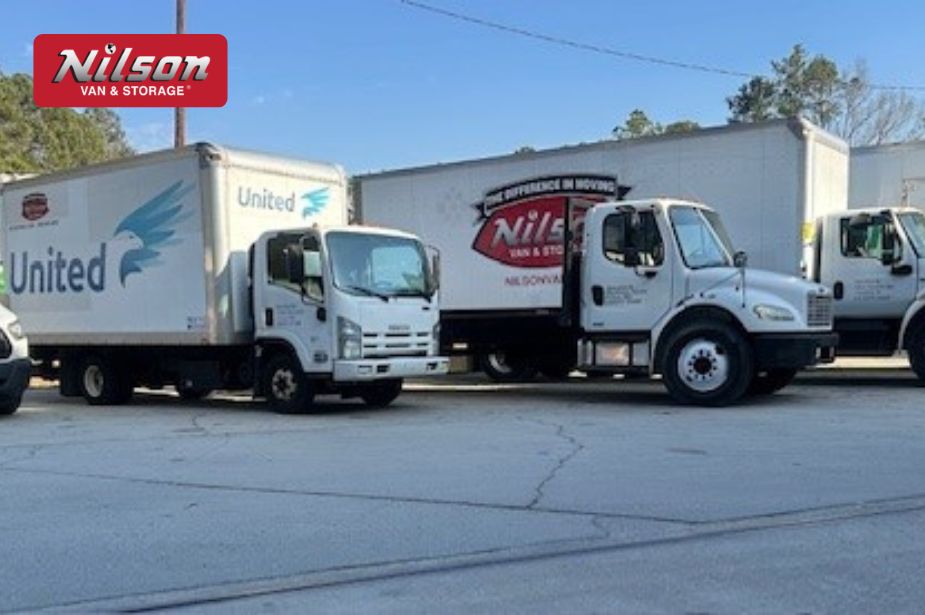
Business Move 101: Planning & Executing Flawless Transition
Moving a business involves much more than just packing boxes and changing addresses. It’s a multifaceted process that demands meticulous planning, coordination, and expertise to ensure continuity and minimize disruption. When you embark on a business move, you’re orchestrating a complex blend of logistics, timing, personnel management, and sensitive equipment handling. That’s why having a reliable partner like Nilson Van and Storage can make all the difference. Serving key South Carolina and Georgia locations—including Columbia, Myrtle Beach, Charleston, Sumter, and Savannah—we specialize in corporate relocation services designed to deliver a seamless transition tailored to your company’s unique needs.
Every business move carries its own set of challenges, from protecting critical data to ensuring your team remains productive throughout the process. Without a structured approach and the right support, even a straightforward office relocation can lead to costly downtime and frustration. This is where a comprehensive commercial moving guide becomes essential. At Nilson Van and Storage, we combine years of experience with in-depth knowledge of local regulations and logistical nuances to handle these challenges proactively. Our transparent valuation coverage protects your assets during transit, providing peace of mind beyond standard insurance. Plus, with our no cancellation fee policy and non-binding local move agreements in South Carolina, your business maintains flexibility and control every step of the way—no surprises, no pressure.
In this guide, we’ll walk you through the fundamental stages necessary for executing a successful office move. From developing a corporate move checklist to selecting experienced business movers Charleston SC trusts, our goal is to equip your company with practical insights that save time and reduce stress. Whether you are relocating a small startup or a large corporate headquarters, understanding the intricacies of a business move helps you stay ahead of potential issues and focus on what truly matters—keeping operations running smoothly. Relying on a dedicated team like Nilson Van and Storage means you benefit from tailored solutions that consider the unique demands of each location in the Southeastern U.S., ensuring your office transition is flawless and aligned with your growth objectives.
Understanding the Basics of a Business Move
What Defines a Business Move?
A business move extends far beyond simply transporting boxes from one location to another. It encompasses the relocation of an entire office environment, including physical office spaces, specialized equipment, technology infrastructure, and often the transition of employees and their workstations. Whether moving a small startup or a large corporate headquarters, the scope typically involves detailed coordination of office furniture, computers, servers, confidential documents, communication systems, and sometimes even manufacturing or retail equipment. The goal is to ensure all essential components seamlessly transfer to the new site without interrupting business operations.
Employee relocation is another critical aspect of a business move. Ensuring staff understand the logistical changes and have a clear path for their own transitional needs helps maintain morale and productivity. As part of the corporate move, businesses may also need to consider parking, access, work environment setup, and compliance with local regulations depending on the new office’s geography—whether in Columbia, Myrtle Beach, Charleston, Sumter, or Savannah.
Key Challenges in Corporate Relocation
Undertaking a corporate move presents a variety of challenges that require foresight and expert handling. One major hurdle is timing; coordinating the move so business operations experience minimal interruption demands a fine-tuned schedule. Without timely execution, delays can cascade into lost revenue and frustrated employees and clients.
Logistics pose complexity as well. Moving heavy or sensitive equipment, coordinating trucks and parking permits, and navigating traffic restrictions are just some of the operational factors that can complicate the process. Ensuring technology infrastructure transfers smoothly—servers, phones, and internet connectivity—is especially critical, as downtime here can cripple productivity.
Clear, consistent employee communication is often underestimated but is paramount to a successful office move. Employees must receive detailed updates about timing, new office layouts, parking spots, and support resources to avoid confusion and maintain engagement.
Another growing concern is data and document security during transit. Corporate documents and IT equipment often contain sensitive or confidential information, requiring secure packing, transport, and handling protocols.
Why Professional Business Relocation Services Matter
Given these challenges, partnering with professional business relocation services is essential for a successful office move. Experienced movers bring specialized knowledge and equipment tailored to corporate relocations—items like padded moving crates, secure data transport procedures, and IT disassembly/reassembly support. These capabilities mitigate risks that standard residential movers may not be equipped to handle.
Hiring experts also helps streamline communication and scheduling. Coordinated efforts among the moving team, company leadership, IT specialists, and building management reduce surprises and prevent costly downtime. Business relocation services can adapt plans in real time to address unexpected challenges, keeping your move on track.
Moreover, reliable movers like Nilson Van and Storage provide valuation protection for your assets, adding a layer of security without labeling it as insurance, which helps safeguard your company’s investment. They offer flexible terms—no cancellation fees, and for South Carolina local moves, non-binding agreements—allowing your business to adjust plans if needed without penalty.
Nilson Van and Storage’s Role Across Columbia, Myrtle Beach, Charleston, Sumter, and Savannah
Nilson Van and Storage stands out as a trusted partner for businesses planning a move throughout the Southeastern U.S., including Columbia, Myrtle Beach, Charleston, Sumter, and Savannah. Our tailored approach respects both the unique logistical challenges and regulatory requirements of each location, ensuring regional expertise guides every transition.
We understand the importance of envisioning every detail—from parking considerations in downtown Charleston to navigating the busy streets of Columbia or the coastal routes near Myrtle Beach. Our business movers Charleston SC relies on are trained to adapt to these nuances, offering personalized service that minimizes disruptions.
With Nilson Van and Storage, companies gain more than just transportation; they secure a comprehensive commercial moving guide crafted from years of field experience. Our commitment to transparent pricing, no cancellation fees, and valuation protection means your business move is in capable hands with the flexibility your organization demands. This groundwork sets the stage for a successful office move that aligns with your operational goals and regional specifics.
Creating Your Corporate Move Checklist for a Business Move
Essential Pre-Move Planning Items
A successful business move starts long before the moving trucks arrive. Establishing a clear pre-move plan is essential to keep every detail on track and avoid last-minute surprises. First, securing all necessary permits and approvals from local authorities and building management is critical, especially in busy metropolitan areas like Charleston or downtown Columbia, where parking and loading zones are regulated. Confirm lease agreements for both your current and future locations to align timing carefully, ensuring no gaps that could disrupt operations.
Budgeting is another foundational step. It’s important to forecast expenses accurately—not just for moving services but also for auxiliary costs such as temporary storage, IT setup, or potential modifications to the new space. Careful financial planning within your corporate move checklist helps prevent unexpected overruns and keeps your business move within scope.
Employee Communication Strategy
An often overlooked but vital part of any corporate relocation is keeping your workforce informed and engaged. Developing a robust communication plan ensures your team remains confident and productive throughout the transition. Start by outlining clear timelines and milestones, sharing updates regularly via email newsletters, meetings, or dedicated intranet pages.
Address common employee concerns upfront—parking changes, new commute routes, workspace configurations, or increased workloads during the move. Providing FAQs or hosting Q&A sessions helps reduce anxiety and builds transparency. When staff feel included and well-informed, the entire company benefits from smoother collaboration and a stronger sense of stability during the transition.
Inventory Management and Asset Tracking
Accurate inventory management forms the backbone of a streamlined business move. Begin by cataloging every item in your current office—from desks and chairs to computers, servers, and sensitive documents. Use detailed spreadsheets or specialized asset management software to track quantity, condition, and location.
Labeling each item clearly facilitates both packing and unpacking, minimizing the risk of lost or damaged equipment. Separating fragile or high-value assets allows your business relocation services team to provide specialized handling and protection where needed. Comprehensive asset tracking also supports insurance valuation coverage, offering peace of mind that your investments are accounted for and safeguarded throughout the move.
Selecting the Right Business Movers Charleston SC and Surrounding Areas
Choosing the right business movers is critical for a successful office move, especially when transitioning within or around Charleston, Columbia, Myrtle Beach, Sumter, and Savannah. Prioritize moving companies with proven commercial experience, excellent client references, and knowledge of local regulations and traffic patterns. Specialized expertise ensures your move respects regional permits, timing restrictions, and building requirements.
Nilson Van and Storage stands out as a preferred choice for business movers Charleston SC businesses and neighboring cities trust. Known for professional handling, valuation protection, and flexible, non-binding contracts for South Carolina locals, Nilson Van and Storage provides the reliability essential for seamless relocation. Equally important is transparent pricing and a no cancellation fee policy, which allows businesses to adjust plans hassle-free—key benefits when managing complex corporate moves.
Timeline Creation and Milestone Setting
Establishing a realistic and detailed timeline is a strategic step to keep your business move on schedule. Break the process into manageable phases—planning, packing, transportation, setup, and post-move follow-ups. Assign clear deadlines and responsible parties to each milestone, allowing progress monitoring and agile response to any delays.
Coordinate your timeline closely with your chosen business relocation services provider to align truck availability, labor allocations, and site access. Building in buffer periods ensures room for unexpected challenges without impacting critical business functions. Regular status meetings and updates anchored to your corporate move checklist help all stakeholders stay aligned, transforming a complex move into an organized, efficient operation.
Designing a thorough commercial moving guide through this checklist stage equips your organization with the tools needed to anticipate challenges, empower staff, and streamline logistics. Partnering with experts like Nilson Van and Storage ensures your business move is managed with professionalism and local insight, paving the way for a successful office move.
Comprehensive Commercial Moving Guide: Step-by-Step Process
Initial Consultation and Detailed Site Assessments
The foundation of a successful business move begins with an in-depth initial consultation and thorough site assessments at both the current and new office locations. This step is crucial to develop a tailored moving strategy that addresses unique spatial layouts, access limitations, and logistical challenges specific to your facility. Nilson Van and Storage prioritizes on-site evaluations in Columbia, Myrtle Beach, Charleston, Sumter, and Savannah to ensure every detail is considered—from loading dock availability to elevator restrictions and traffic flow. These assessments enable precise planning, minimize unexpected hurdles on moving day, and streamline coordination among all parties involved.
Packing and Labeling Best Practices
The packing phase demands meticulous attention to organization and protection to avoid damage or misplaced items during the move. Employing best practices, such as using color-coded labels and comprehensive inventories, dramatically improves unpacking efficiency and reduces downtime. Fragile or high-value equipment should be secured with custom packing materials designed to cushion and stabilize, while sensitive documents require secure containers clearly marked for priority handling. Incorporating these practices into your corporate move checklist ensures that all team members and business relocation services know exactly where each item belongs at the destination, contributing to a successful office move and a smoother transition.
IT Infrastructure Relocation Considerations
Relocating IT infrastructure represents one of the most critical—and sensitive—aspects of a business move. Planning to minimize downtime is paramount for maintaining communication, data integrity, and workflow continuity. Prioritize early collaboration with your IT department and your moving partner, like Nilson Van and Storage, to schedule disassembly, secure transport, and precise reinstallation of servers, telecom systems, and workstations. Specialized handling protocols and protective equipment help safeguard hardware from jostling or static damage. Additionally, aligning technology setup timelines with your overall move schedule prevents service interruptions that could impact employees and clients alike.
Transportation and Logistics Planning
Transportation logistics form the backbone of a flawless business move. This stage involves route optimization to avoid delays caused by traffic congestion or road restrictions common in urban centers like Charleston or Columbia. Business movers Charleston SC relies upon, such as Nilson Van and Storage, leverage local expertise to navigate regulations and timing constraints effectively. Moreover, proper handling of specialty equipment—such as heavy filing systems or delicate manufacturing tools—requires specialized vehicles and careful loading techniques. Ensuring trucks are adequately sized and parking permits secured ahead of time mitigates common obstacles, keeping your move on schedule and within budget.
On-Site Coordination and Supervision
Coordination on moving day demands skilled supervision to manage the various moving teams, maintain communication, and troubleshoot any emerging issues promptly. A dedicated move coordinator from Nilson Van and Storage oversees every stage to guarantee processes adhere to the agreed timeline and quality standards. This onsite leadership streamlines the setup of furniture, IT systems, and office supplies, ensuring each workspace is functional as quickly as possible. Immediate resolution of challenges—such as unexpected facility constraints or equipment compatibility—prevents costly delays and supports a smooth transition toward resuming normal operations.
Post-Move Services and Support
Completing a successful business move extends beyond unloading. Post-move services, including unpacking assistance and disposal of packing materials, expedite settling into the new space. Nilson Van and Storage offers follow-up support where staff can request help for adjustments or report missing items. Conducting a final walkthrough to verify that all assets arrived intact and properly installed confirms closure on the relocation phase. Although storage options may be part of your move plan, it’s important to remember Nilson Van and Storage provides valuation protection—not formal insurance—and offers flexible, no cancellation fee agreements to maintain your peace of mind throughout your business move journey.
This commercial moving guide outlines the detailed, professional approach necessary to execute a flawless business move. Partnering with knowledgeable, regionally experienced teams ensures your company navigates each phase seamlessly, reducing operational impact and setting the stage for ongoing success in your new office.
Ensuring a Successful Office Move with Employee Productivity in Mind
Minimizing Business Downtime
Keeping your business operational during a move is one of the toughest challenges in any business move. Maintaining productivity while transitioning to a new space requires careful scheduling and proactive measures. One effective strategy is to plan the bulk of the relocation during off-peak hours or over weekends to reduce interruptions to normal workflow. Breaking the move into stages—such as relocating departments or teams gradually rather than all at once—also helps sustain essential functions.
Partnering with experienced business relocation services like Nilson Van and Storage means you benefit from professionals skilled at timing logistics to avoid unnecessary downtime. They coordinate closely with your internal teams to sync transport, setup, and technology installation, so systems are operational as quickly as possible. Maintaining open lines of communication keeps all departments abreast of progress, allowing for contingency adjustments that protect productivity throughout the transition.
Employee Support and Engagement
A successful office move depends heavily on how well employees feel supported and informed. Clear, consistent communication is key to minimizing any anxiety or confusion. Providing readily accessible resources—such as an internal move FAQ, detailed schedules, and contact points for move-related questions—helps employees prepare in advance.
Regular updates through meetings or digital channels foster a collaborative atmosphere, empowering staff to voice concerns and suggestions. Additionally, training sessions or orientation for the new space can ease adjustment and promote enthusiasm about the change. Nilson Van and Storage supports this approach by offering expert guidance and ensuring the move process is transparent, so your team experiences less disruption and stays motivated from start to finish.
Setting Up the New Workspace for Efficiency
Moving into a new office provides a unique opportunity to design a workspace that enhances efficiency and employee well-being. Thoughtful layout planning—focusing on natural light, ease of movement, and noise control—can boost comfort and collaboration. Ergonomic considerations, including adjustable desks, proper chair support, and strategically placed technology, reduce fatigue and the risk of injury, which contributes to sustained productivity.
Engaging employees in the design process helps ensure the new environment aligns with their needs and fosters engagement. Business movers Charleston SC trusts, like Nilson Van and Storage, don’t just deliver your furniture and equipment—they assist with organized setup that supports your chosen office design and operational goals. A well-planned setup accelerates resumption of work and enhances overall employee satisfaction.
Handling Unexpected Challenges
Even with the best-laid plans, unforeseen challenges can arise during a business move. Weather delays, last-minute equipment malfunctions, or space access issues can threaten to derail your schedule. Preparing contingency plans in advance ensures your move keeps momentum despite obstacles.
Having a trusted moving partner such as Nilson Van and Storage at your side means quick, effective problem-solving from experienced professionals who understand the regional nuances of moves in Columbia, Myrtle Beach, Charleston, Sumter, and Savannah. Their non-binding agreements for South Carolina locals and no cancellation fee policies add flexibility, making it easier to adapt plans as situations evolve.
Maintaining open communication channels during the move ensures issues are addressed promptly and transparently, minimizing stress for both management and employees. With resilience built into your corporate move checklist, your business stays on course toward a successful office move that maintains productivity and morale.
Why Choose Nilson Van and Storage for Your Business Move in the Southeast US?
Specialized Corporate Moving Services
Nilson Van and Storage offers comprehensive business relocation services designed specifically for office and commercial moves. We understand that corporate relocations involve more than just transporting furniture — they require careful handling of sensitive technology, confidential documents, and specialized equipment. Our team is trained to manage complex moves with precision, offering custom solutions such as secure packing, IT disassembly and reinstallation support, and coordinated logistics that cater to your company’s unique needs. This specialized approach ensures your business move minimizes disruptions and safeguards your assets at every stage.
Local Expertise Across Columbia, Myrtle Beach, Charleston, Sumter, and Savannah
Relocating a business within or between cities demands intimate knowledge of local traffic patterns, municipal regulations, and building protocols. Nilson Van and Storage leverages years of experience operating throughout Columbia, Myrtle Beach, Charleston, Sumter, and Savannah, giving us a distinct advantage in planning efficient routes and securing necessary permits for commercial moves. Our familiarity with regional nuances—such as timing restrictions on busy streets or specialized loading zone requirements—helps prevent unexpected delays and compliance issues. This localized expertise equips us to tailor your business relocation for seamless execution, no matter the destination in the Southeast US.
Transparent Pricing and No-Fee Cancellation Policy
Cost certainty and flexibility are critical when planning a business move. Nilson Van and Storage commits to clear, upfront pricing that eliminates hidden fees or surprise charges, empowering you to budget with confidence. Additionally, our no cancellation fee policy and non-binding contracts for South Carolina local moves provide peace of mind should plans change unexpectedly. This flexibility, paired with our valuation protection—which offers added security for your assets without formal insurance complications—means you can trust Nilson Van and Storage to be a transparent, dependable partner throughout your business move.
Testimonials and Proven Track Record
Our reputation as trusted business movers Charleston SC and nearby markets rely on is built on satisfied clients and successful office moves. From startups to established enterprises, many have praised Nilson Van and Storage for our professionalism, punctuality, and attention to detail. Clients appreciate how we adapt to their specific moving challenges while maintaining open communication and delivering on promises. These testimonials reflect our unwavering commitment to quality and customer satisfaction, making Nilson Van and Storage the preferred choice for companies seeking a flawless corporate move experience across the Southeast.
Wrapping Up
Successfully executing a business move demands more than just moving boxes—it requires detailed planning, expert coordination, and working with a partner who understands the nuances of corporate relocations. Nilson Van and Storage stands ready to support businesses throughout Columbia, Myrtle Beach, Charleston, Sumter, and Savannah with comprehensive corporate move services designed to keep your project on schedule and within budget. Our professional team follows a strategic approach informed by a thorough commercial moving guide and tailored corporate move checklist, ensuring every phase—from pre-move planning to post-move support—is handled with precision and care.
By choosing Nilson Van and Storage as your trusted business movers Charleston SC and surrounding areas depend on, you gain access to experienced experts committed to minimizing downtime and protecting your valuable assets through valuation protection. With no cancellation fees and flexible, non-binding contracts for South Carolina local moves, your company maintains control and peace of mind during this complex process. Leveraging our regional expertise and responsive service, your office transition will not only be efficient and stress-free but positioned to set the foundation for continued success in your new workspace.

FAQs - Business Move
Our Recent Articles
Stay informed and inspired with the latest tips, insights, and updates from the Nilson Van and Storage blog. From expert packing advice and moving checklists to stories about our commitment to the community, our articles are here to make your relocation journey smoother and stress-free. Explore our recent posts to discover how we’re redefining the moving experience for Columbia, Myrtle Beach, Charleston, Sumter, Savannah, and beyond.

Move to Germany from Columbia with Reliable Moving Company

Expert Hotel Moving Services in Columbia for Efficient Move

